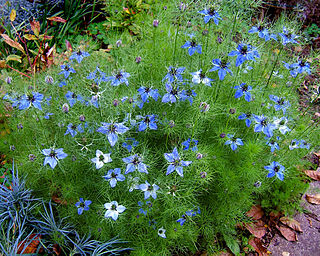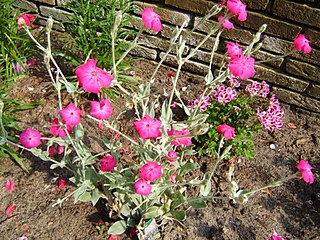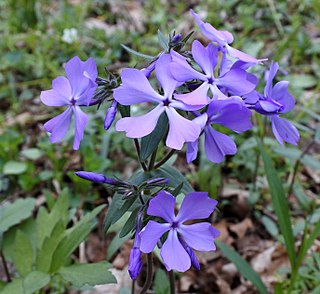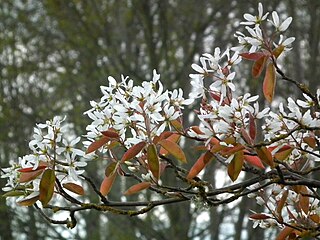
The Royal Horticultural Society (RHS), founded in 1804 as the Horticultural Society of London, is the UK's leading gardening charity.

Nicotiana is a genus of herbaceous plants and shrubs in the family Solanaceae, that is indigenous to the Americas, Australia, Southwestern Africa and the South Pacific. Various Nicotiana species, commonly referred to as tobacco plants, are cultivated as ornamental garden plants. N. tabacum is grown worldwide for the cultivation of tobacco leaves used for manufacturing and producing tobacco products, including cigars, cigarillos, cigarettes, chewing tobacco, dipping tobacco, snuff, and snus.

Epimedium, also known as barrenwort, bishop's hat, fairy wings, horny goat weed, or yin yang huo, is a genus of flowering plants in the family Berberidaceae. The majority of the species are endemic to China, with smaller numbers elsewhere in Asia, and a few in the Mediterranean region.

Nigella damascena, love-in-a-mist, or devil in the bush, is an annual garden flowering plant, belonging to the buttercup family Ranunculaceae. It is native to southern Europe, north Africa and southwest Asia, where it is found on neglected, damp patches of land.

Epimedium sagittatum is a flowering plant in the barberry family (Berberidaceae) native to China. It is known locally as 三枝九叶草 and is sometimes called horny goat weed for its purported aphrodisiac properties.

Ulex europaeus, the gorse, common gorse, furze or whin, is a species of flowering plant in the family Fabaceae, native to the British Isles and Western Europe.

Ribes sanguineum, the flowering currant, redflower currant, red-flowering currant, or red currant is a North American species of flowering plant in the family Grossulariaceae, native to the western United States and Canada.

Silene coronaria, the rose campion, is a species of flowering plant in the family Caryophyllaceae, native to Asia and Europe. Other common names include dusty miller, mullein-pink and bloody William. In the United Kingdom it is still widely referenced under its synonym Lychnis coronaria.

Matthiola incana is a species of flowering plant in the cabbage family Brassicaceae. Common names include Brompton stock, common stock, hoary stock, ten-week stock, and gilly-flower. The common name stock usually refers to this species, though it may also be applied to the whole genus Matthiola. The common name "night-scented stock" or "evening-scented stock" is applied to Matthiola longipetala.

Phlox divaricata, the wild blue phlox, woodland phlox, or wild sweet william, is a species of flowering plant in the family Polemoniaceae, native to forests and fields in eastern North America.

Viburnum plicatum is a species of flowering plant in the family Adoxaceae, native to mainland China, Korea, Japan, and Taiwan. The Latin specific epithet plicatum means “pleated”, referring to the texture of the leaves.

Jasminum officinale, known as the common jasmine or simply jasmine, is a species of flowering plant in the olive family Oleaceae. It is native to the Caucasus and parts of Asia, also widely naturalized.

Ranunculus aconitifolius, the aconite-leaf buttercup or bachelor's buttons, is a species of flowering plant in the buttercup family Ranunculaceae, native to central Europe. Growing to 60 cm (24 in) high by 40 cm (16 in) broad, this herbaceous perennial has slightly hairy palmate leaves up to 20 cm (8 in) long, and loose panicles of white, saucer-shaped flowers in spring.

Amelanchier × grandiflora, the serviceberry, is a small deciduous flowering tree or large shrub, a hybrid of garden origin between A. arborea and A. laevis, in the family Rosaceae. It produces white flowers and small red to purple edible fruits.

Galega, goat's rue, is a genus of flowering plants in the legume family, Fabaceae, native to central and southern Europe, western Asia and tropical east Africa. They are tall, bushy, herbaceous perennials with erect racemes of pea-like flowers in shades of white, pink, blue or mauve. Their preferred habitats are sunny damp meadows or slopes.

Epimedium × rubrum, known as red barrenwort, is a species of perennial flowering plant in the family Berberidaceae, cultivated in gardens. It is considered to be a hybrid between E. alpinum and E. grandiflorum. The Royal Horticultural Society has given it the Award of Garden Merit (AGM).

Impatiens sodenii is a species of flowering plant in the family Balsaminaceae known by the common names poor man's rhododendron, Oliver's touch-me-not, and shrub balsam. It is native to Kenya and Tanzania, and widely cultivated as an ornamental plant.

Epimedium alpinum, the alpine barrenwort, is a species of flowering plant in the genus Epimedium, native to the mountains of Italy, Austria, the former Yugoslavia, and Albania, and introduced into central Europe. A dwarf perennial suitable for rock gardens, it was jocularly said by John Lindley to be "known only in the gardens of botanists". Its hybrid with E. grandiflorum, Epimedium × rubrum, has gained the Royal Horticultural Society's Award of Garden Merit.

Symphyotrichum turbinellum, commonly called prairie aster in the United States and mauve-flowered starwort in the United Kingdom, is a species of flowering plant in the family Asteraceae native to the United States in Arkansas, Illinois, Iowa, Kansas, Louisiana, Missouri, Nebraska, and Oklahoma, primarily in the Ozarks. It has gained the Royal Horticultural Society's Award of Garden Merit.

Symphytum grandiflorum, the creeping comfrey, or running comfrey is a species of flowering plant in the family Boraginaceae. It is native to the Caucasus region, and introduced to various locales in Europe as a garden escapee. A deer-tolerant perennial, it is hardy in USDA zones 5 through 8, and is recommended for borders and shady situations. The unimproved species and a number of cultivars are commercially available, including 'Goldsmith', 'Hidcote Blue' and 'Hidcote Pink'.





















